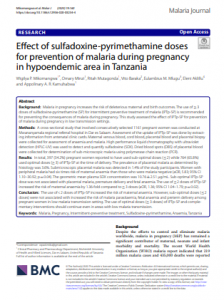
Background
Malaria in pregnancy increases the risk of deleterious maternal and birth outcomes. The use of ≥ 3 doses of sulfadoxine-pyrimethamine (SP) for intermittent preventive treatment of malaria (IPTp-SP) is recommended for preventing the consequences of malaria during pregnancy. This study assessed the effect of IPTp-SP for prevention of malaria during pregnancy in low transmission settings.
Methods
A cross-sectional study that involved consecutively selected 1161 pregnant women was conducted at Mwananyamala regional referral hospital in Dar es Salaam. Assessment of the uptake of IPTp-SP was done by extracting information from antenatal clinic cards. Maternal venous blood, cord blood, placental blood and placental biopsy were collected for assessment of anaemia and malaria. High performance liquid chromatography with ultraviolet detection (HPLC-UV) was used to detect and quantify sulfadoxine (SDX). Dried blood spots (DBS) of placental blood were collected for determination of sub-microscopic malaria using polymerase chain reaction (PCR).
Results
In total, 397 (34.2%) pregnant women reported to have used sub-optimal doses (≤ 2) while 764 (65.8%) used optimal doses (≥ 3) of IPTp-SP at the time of delivery. The prevalence of placental malaria as determined by histology was 3.6%. Submicroscopic placental malaria was detected in 1.4% of the study participants. Women with peripheral malaria had six times risk of maternal anaemia than those who were malaria negative (aOR, 5.83; 95% CI 1.10–30.92; p = 0.04). The geometric mean plasma SDX concentration was 10.76 ± 2.51 μg/mL. Sub-optimal IPTp-SP dose was not associated with placental malaria, premature delivery and fetal anaemia. The use of ≤ 2 doses of IPTp-SP increased the risk of maternal anaemia by 1.36-fold compared to ≥ 3 doses (aOR, 1.36; 95% CI 1.04–1.79; p = 0.02).